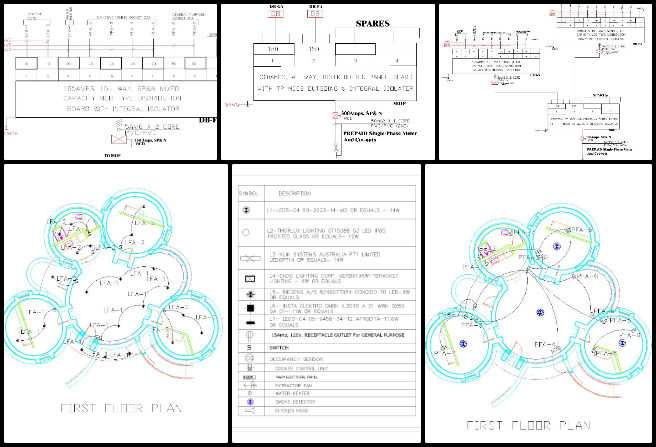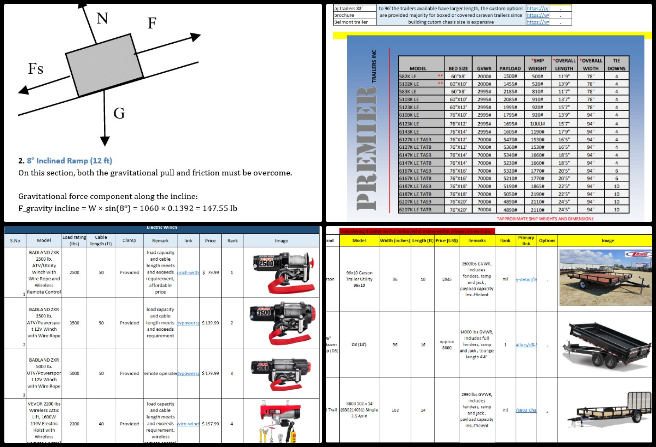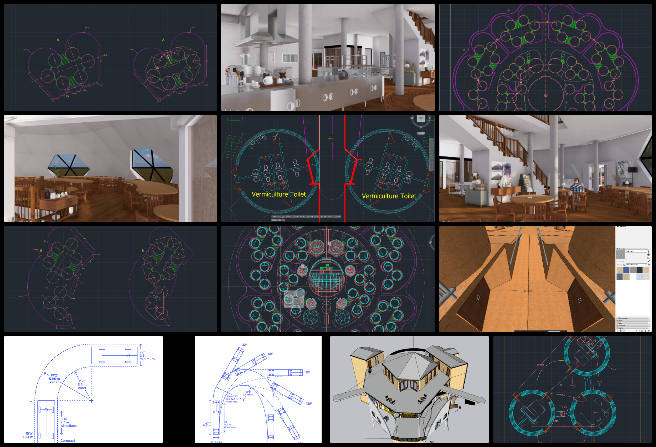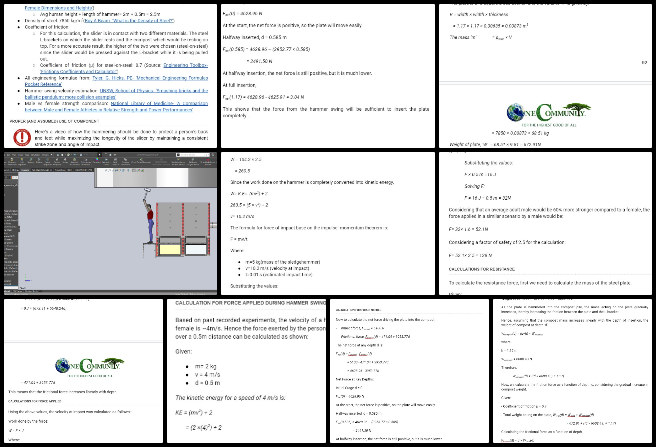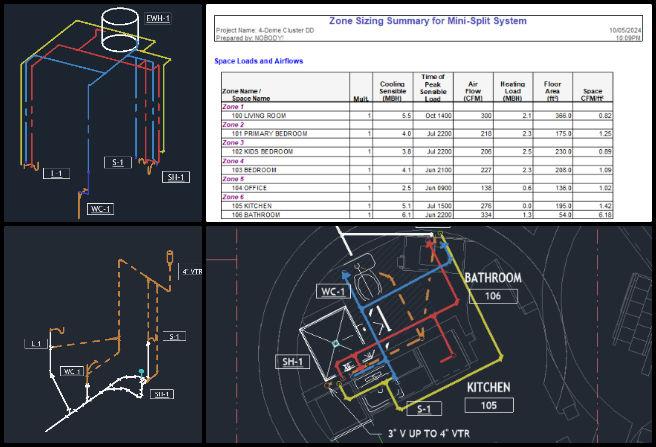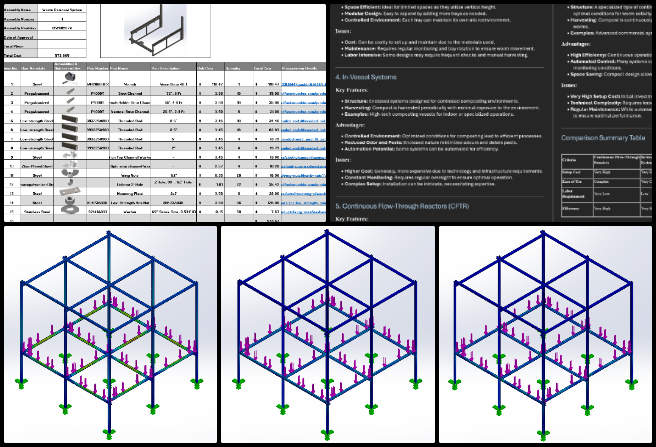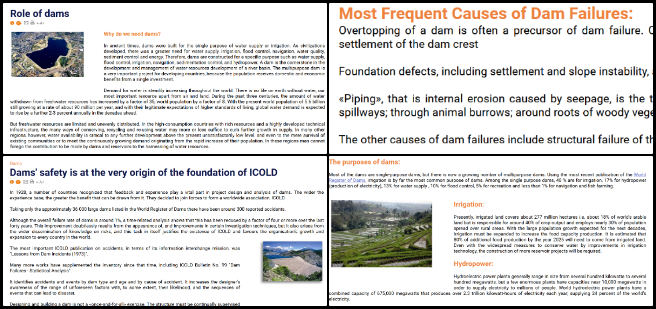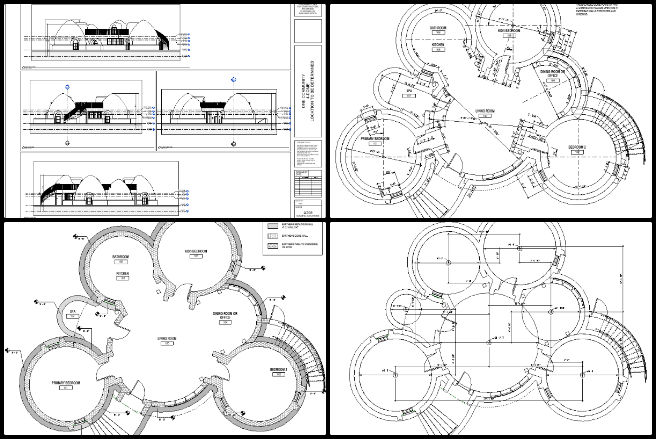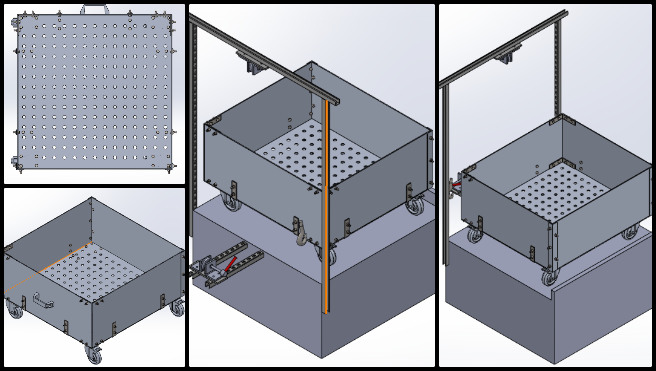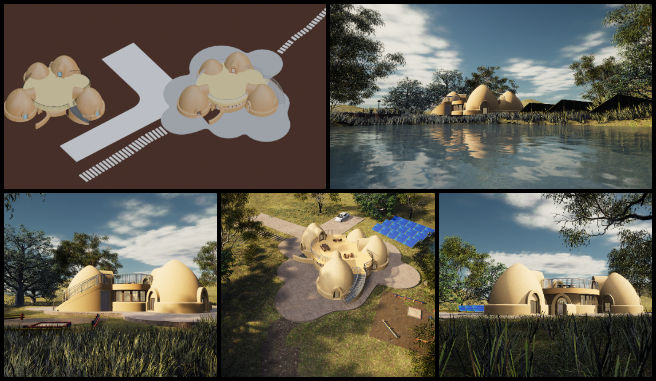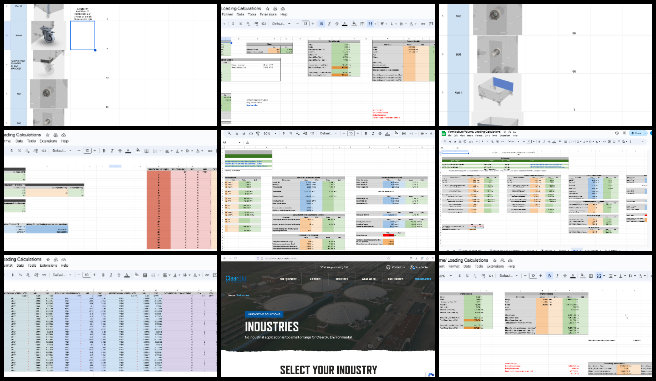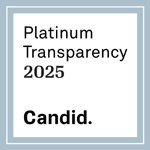
Riddhisha
As you work, be sure to frequently “Update” so you don’t lose work. If you ever DO lose work, it should prompt you to restore it when you return to this page. If it doesn’t then, use the “Revisions” option at right.
HIGHEST GOOD HOUSING #603 ” WORK FOR 9-29 TO 10-05 ” ready
This week, Adefola (Fola) Madehin (Electrical Design Specialist) continued his work with Earthbag Village electrical designs. Fola completed the lighting and power design for the first floor of the Earthbag Village 4 Dome Project. The design covered essential elements such as lighting fixtures, switches, cable wiring, exhaust fans, and kitchen hoods. Socket provisions were made for appliances including TVs, air conditioning units, dishwashers, washing machines, and electric cookers. A main electrical panel schematic diagram was also developed, outlining circuit connections and specifying cable. The Earthbag Village is the first of 7 to be built as the housing component of One Community’s open source model for becoming the most reparative element. See some of his work in the collage below.
Adil Zulfiquar (Engineer) continued working on the Vermiculture Toilet designs. This model aims to offer sustainable solutions that not only address waste processing but also enhance living standards by becoming the most reparative element. Adil held a discussion with the architect to evaluate the feasibility of widening the ramp and the factors involved. The wide-body trailer list page was updated to incorporate additional considerations and challenges. A list of electric winch options was explored and organized, followed by finalizing and verifying the calculations for winch requirements to load containers at various angles. Options for utility trailers were prepared, taking into account the new wide-body design requirement. Custom trailer options were researched and analyzed through discussions with vendors to better understand their offerings, while further insights were gained into the container loading and unloading processes. The Earthbag Village is the first of 7 to be built as the housing component of One Community’s open source model for becoming the most reparative element. See some of his work in the collage below. See below for some of the pictures related to this work.
Akshit Sethi (Architectural Designer) began working on finalizing the interior of the Earthbag Village 4-dome home design. Akshit worked on the AutoCAD file for The EarthBag Village to address the size discrepancies between the ramp and paths in the SketchUp and CAD files. In addition to resolving these inconsistencies, he focused on elevating the document to a professional standard, ensuring it aligned with the quality of existing drawings by One Community. His tasks included adding precise dimensions and correcting any issues related to sizes and standards, ensuring the file met all necessary specifications for further use. The Earthbag village is the first of 7 villages to be built as part of One Community’s open source model for becoming the most reparative element. See his work in the collage below.
Anil Karathra (Mechanical Engineer) continued working on the Vermiculture Toilet designs. Anil researched the forces involved in swinging a hammer for impact and developed a CAD model to calculate the space required under an eco-toilet cabin. He participated in a team meeting and worked on the finite element analysis (FEA) of a winch system. Additionally, he modified the task list by adding new sections and completed document formatting tasks. He recalculated previous numbers for a new FEA based on his research on the forces applied to swing a hammer. He also updated the hammer impact calculations in a slide for the vermiculture collaboration document. The approach of becoming the most reparative element enables the development of innovative solutions that are both environmentally friendly and effective. See below for some of the pictures related to this work.
Avery Hamilton (Mechanical Designer) began working on finalizing the interior of the Earthbag Village 4-dome home design. Avery worked on developing a HAP model, documenting both the HAP assumptions and the envelope dimensions to ensure accuracy. The process included routing the rough-ins for plumbing systems, which required detailed planning to accommodate the building layout. Avery also created Revit risers for both domestic and sanitary piping systems, ensuring proper integration within the overall design. In addition to these tasks, Avery conducted research on the 2018 International Residential Code (IRC), focusing specifically on the requirements for residential range hoods and domestic water recirculation systems to ensure compliance with current regulations. The Earthbag village is the first of 7 villages to be built as part of One Community’s open source model for becoming the most reparative element. See his work in the collage below.
Joseph Osayande (Mechanical Engineer) continued helping finish the Vermiculture Toilet engineering and design details. Joseph focused on enhancing the bill of materials (BOM) by adding images and providing more extensive details for each part, as well as a breakdown of the overall costs. A mesh was created for the main structure of the vermiculture chamber, followed by analysis to gather the required outputs. Additionally, the reports comparing the vermiculture systems and the walkthrough for the FEA analysis were converted to the default format required for One Community Global. The Earthbag Village is the first of 7 to be built as the housing component of One Community’s open source model for becoming the most reparative element. See some of his work in the collage below.
Loza Ayehutsega (Civil Engineer/Assistant Civil Engineer) completed another week working on the Earth Dam risk assessment and dam break hazard assessment. Loza followed webinars and conferences about dam safety engineering. She is a member of ICOLD(International Commission on Large Dams). The International Commission on Large Dams (ICOLD) is a prominent international non-governmental organization dedicated to professionally sharing information regarding large dams. Dam safety engineering is a critical field that focuses on the design, evaluation, monitoring, and rehabilitation of dams to ensure their integrity and the safety of surrounding communities. This discipline encompasses various methodologies, risk management practices, and technological solutions that aim to reduce the likelihood of dam failures and their associated consequences. Ensuring dam safety measures and preparedness are a foundation of One Community’s open source earthworks as part of becoming the most reparative element. See the pictures below for examples related to her work.
Michaela Silva (Architect) continued working on finalizing the interior of the Earthbag Village 4-dome home design. Michaela focused on coordinating the updated 4-dome floor plans with the MEP and Roof Deck teams, and confirmed that the team was using the correct structural plan. She also reviewed electrical drawings and schedules to ensure they aligned with the architectural plan. In addition to this coordination, Michaela continued updating the plan views to incorporate the latest design changes. The Earthbag village is the first of 7 villages to be built as part of One Community’s open source model for becoming the most reparative element. See her work in the collage below.
Prarthana Jathar (Architectural Designer) began working on the Vermiculture Toilet engineering and design details. Prarthana’s work focused on the Earthbag Village project, specifically on the 4-dome cluster roof design, section views, and related reports. Prarthana exported the Revit model to Rhino, created internal renders using TwinMotion, and participated in a weekly meeting to discuss task progress. She also worked on rendering internal views using Revit and Enscape, and downloaded necessary components for the renderings. The time entries reflect steady progress across multiple days of the week. The Earthbag Village is the first of 7 to be built as the housing component of One Community’s open source model for becoming the most reparative element. See some of her work in the collage below.
images needed
Yagyansh Maheshwari (Mechanical Engineer) continued helping finish the Vermiculture Toilet engineering and design details. Yagyansh worked on reducing the bolt length to the minimum, and the bolt was replaced with a lock bolt where required. The fit of the drawer to the dome was checked, and finite element analysis (FEA) was performed on the drawer to assess its capacity to handle the weight and the pulling force of the winch. The Earthbag Village is the first of 7 to be built as the housing component of One Community’s open source model for becoming the most reparative element. See some of his work in the collage below.
Yuxing Xu (VFX Artist) continued working on making videos for the Earthbag Village 4-dome home design. Yuxing focused on the updated building model, receiving the obj file and improving the geometry by separating material layers and fixing mesh openings. He imported the model into Unreal Engine for material assignment and made adjustments to the surrounding environment, with particular attention to refining the shape of the pond.The Earthbag Village is the first of 7 to be built as the housing component of One Community’s open source model for becoming the most reparative element. See some of his work in the collage below.
Yuze Tang (Architect) started working on Vermiculture Toilet designs. Yuze focused on three primary tasks. The first task involved finalizing the aesthetic enhancements to a spreadsheet, excluding Joseph’s table, as it was noted in last week’s meeting that Joseph would handle that section. Next, Yuze initiated a new spreadsheet aimed at analyzing cost reduction for a drawer project. This involved constructing the table and transferring data from the CAD file. The final task entailed researching the development of home biogas systems, with plans to compile the findings into a Word document. The approach of becoming the most reparative element enables the development of innovative solutions that are both environmentally friendly and effective. See below for some of the pictures related to this work.
EARTHBAG VILLAGE 4-DOME ROOF TEAM
The Earthbag Village 4-dome Roof Team was managed by Khushboo Parmar (Project Manager) and includes Karthik Pillai (Volunteer Mechanical Engineer) and Yusuf Thanawala (Structural Engineer). The Earthbag Village forms the basis of One Community’s open source model for becoming the most reparative element. This week, Khushboo led the Earthbag Village MEP bi-weekly meeting, concentrating on team communication to initiate the project’s HVAC component while ensuring alignment between mechanical and architectural aspects. The meeting addressed blockers and questions to facilitate project progress. Additionally, she chaired the 4-Dome Cluster Roof weekly meeting, where she ensured project alignment and established next steps. Khushboo also handled administrative tasks, including verifying that all team members had access to project documents. Khushboo also manages Michaela Silva, Adefola Madehin, Prarthana Jathar, and Avery Hamilton. Karthik conducted wood FEA analysis using Tekla software, exploring its functionalities through tutorials to effectively tackle current design challenges and enhance structural analysis. Yusuf completed his STAAD model and is currently working on the report elements for the 4-Dome structural report, referencing similar previous calculations from the project and planning to include STAAD verification calculations. He aims to complete this task by Sunday and will forward it for review to all involved. The Earthbag village is an integral part of One Community’s open source model for becoming the most reparative element. See their work in the collage below.
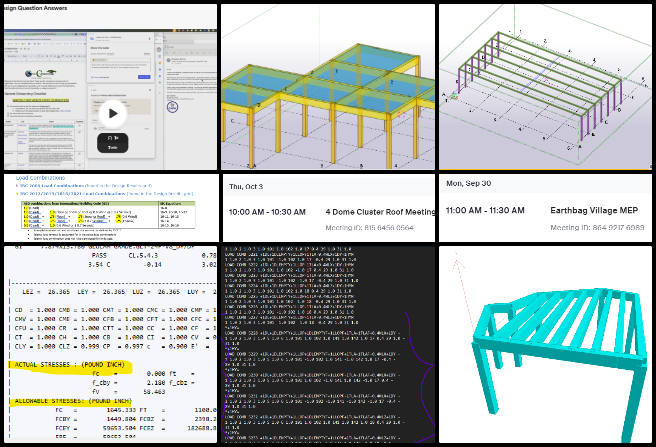
For Reference-
This week, Adil (Engineer) continued working on Vermiculture Toilet designs. Adil collaborated with an Architecture Engineer to review SketchUp and AutoCAD layouts of the Earthbag Village, identifying necessary design modifications. An analysis was conducted on the kitchen door panel drawing to evaluate feasibility options for both two-container and four-container configurations. Research was done on electric winch options for pulling a container onto a trailer, taking into account factors such as load weight and pulling angle. Calculations were performed to select an appropriate winch based on capacity and incline loading forces. Additionally, three trailer options for transporting four containers were finalized, considering ramp width and door opening clearance, and a list was organized detailing the pros, cons, and pricing of each trailer to assist in decision-making. This model aims to offer sustainable solutions that not only address waste processing but also enhance living standards, forwarding the human evolution matrix. See below for some of the pictures related to his work.
Akshit Sethi (Architectural Designer) began working on finalizing the interior of the Earthbag Village 4-dome home design. Akshit focused on analyzing the AutoCAD file for The EarthBag Village, identifying and addressing size discrepancies between the ramp and paths in the SketchUp and CAD files. Additionally, he worked on optimizing the SketchUp file by separating the domes to reduce its overall size, facilitating smoother workflow in Lumion. In Lumion, he added materials and entourage to enhance the model and gain a better understanding of space usage and lighting settings, further refining the design for improved visualization and functionality. The Earthbag village is the first of 7 villages to be built as part of One Community’s open source model for forwarding the human evolution matrix. See his work in the collage below.
Anil Karathra (Mechanical Engineer) continued working on Vermiculture Toilet designs. Anil recalculated the number of hammer strokes required to position the slider before removing the drawers and updated the task list with new tasks as needed. He worked on formatting documentation, re-verifying calculations, and participated in the weekly team call. Additional efforts focused on continuing documentation and starting the finite element analysis (FEA) for the winch holder. Detailed force calculations were made to determine the amount of force needed to insert the slider plate into the compost, and the positioning of a human model within the eco-toilet assembly was explored. Documents were updated, feedback provided, weekly meetings scheduled, and the task list was revised accordingly. The approach of forwarding the human evolution matrix enables the development of innovative solutions that are both environmentally friendly and effective. The Earthbag Village is the first of 7 to be built as the housing component of One Community’s open source model for forwarding the human evolution matrix. See some of his work in the collage below.
Avery Hamilton (Mechanical Designer) began working on finalizing the interior of the Earthbag Village 4-dome home design. Avery completed the onboarding document and reviewed the current architectural plans. He broke down an action item into subtasks and created a Google Sheet to organize this information. He installed Revit 2025, created a mechanical Revit model, and used Bluebeam to extract envelope dimensions from the existing PDF set. He initiated a HAP model based on the Bluebeam markups. After reviewing the Plumbing BOD and an article on automated systems, he formulated questions for the engineering team and drafted an email to address these queries. The Earthbag village is the first of 7 villages to be built as part of One Community’s open source model for forwarding the human evolution matrix. See his work in the collage below.
Joseph Osayande (Mechanical Engineer) continued helping finish the Vermiculture Toilet engineering and design details. Joseph focused on identifying all the parts of the Winch Removal System (WRS) using the exploded view tool and creating detailed drawings. A bill of materials (BOM) was also generated to outline the components needed for a cost estimate, covering both materials and potential manufacturing processes. Specifications for the winch were taken into consideration. Additionally, work began on a step-by-step assembly guide, which is used for the assembly order, recommended tools, and any necessary precautions for constructing the winch removal system. This model aims to offer sustainable solutions that not only address waste processing but also enhance living standards by forwarding the human evolution matrix. The Earthbag Village is the first of 7 to be built as the housing component of One Community’s open source model for forwarding the human evolution matrix. See some of his work in the collage below.
Michaela Silva (Architect) continued working on finalizing the interior of the Earthbag Village 4-dome home design. Michaela completed the model changes to the 4-dome single family home Revit model and shared it with the team to discuss options for the structural frame. She created an interior and exterior finish schedule to incorporate the selected materials. Additionally, Michaela continued to import detailed information and descriptions from the One Community website into Revit, making modifications applicable to the 4-dome home. The Earthbag village is the first of 7 villages to be built as part of One Community’s open source model for forwarding the human evolution matrix. See her work in the collage below.
Prarthana Jathar (Architectural Designer) began working on the Vermiculture Toilet engineering and design details. Prarthana focused on AutoCAD to create building footprints and calculate areas for all villages. Over the week, she added the nameplates and layouts for the autocad files. Additionally, she worked on drafting village footprints and provided necessary dimensions to finalize the layouts. The tasks were spread over multiple days, with five hours of work allocated each day. The Earthbag Village is the first of 7 to be built as the housing component of One Community’s open source model for forwarding the human evolution matrix. See some of her work in the collage below.
Yagyansh Maheshwari (Mechanical Engineer) continued helping finish the Vermiculture Toilet engineering and design details. Yagyansh worked on reducing the bolt length to the minimum, and the bolt was replaced with a lock bolt where required. The fit of the drawer to the dome was checked, and finite element analysis (FEA) was performed on the drawer to assess its capacity to handle the weight and the pulling force of the winch. The Earthbag Village is the first of 7 to be built as the housing component of One Community’s open source model for forwarding the human evolution matrix. See some of his work in the collage below.
Yi-Ju Lien (Environmental Engineer) began working on the Earth Dam risk assessment and dam break hazard assessment. Yi-Ju joined One Community as a volunteer engineer. She began by familiarizing herself with the organization’s previous work through the website. Following that, she reviewed the tutorial on Hydro Power/Energy Setup and Maintenance, as well as the DIY Earth Dam Design & Construction guide, providing suggestions from a reader’s perspective. Additionally, she studied the estimation methods for dam breach parameters and proposed several regression equation options while assessing the potential risks associated with a dam. Ensuring dam safety measures and preparedness are a foundation of One Community’s open source earthworks as part of forwarding the human evolution matrix. See the pictures below for examples related to her work.
Yuxing Xu (VFX Artist) continued working on making videos for the Earthbag Village 4-dome home design. Yuxing worked on the environment for the 4-dome flyover and walkthrough video, focusing on the equipment and accessories essential to the visual representation of the exterior scene, such as the Tesla charger, swimming pool, and bathtub. He also made adjustments to the landscape, enhancing its greenery. These updates were made in response to feedback provided by Jae. The Earthbag Village is the first of 7 to be built as the housing component of One Community’s open source model for forwarding the human evolution matrix. See some of his work in the collage below.
Yuze Tang (Architect) started working on Vermiculture Toilet designs. Yuze corrected the numerical formatting of the beautified table in the ‘Yuze’ and ‘Yuze_Sheet4’ sheets, completed the beautification of ‘Yuze_Sheet4’, and reviewed the calculations in Joseph’s work within the spreadsheet. He also familiarized himself with Md’s tasks, checked the accuracy of Md’s calculations, and conducted research on industrial vehicles using bio-fuel, focusing on options that could be purchased in Africa. The approach of forwarding the human evolution matrix enables the development of innovative solutions that are both environmentally friendly and effective. See below for some of the pictures related to this work.
images needed
EARTHBAG VILLAGE 4-DOME ROOF TEAM
The Earthbag Village 4-dome Roof Team was managed by Khushboo Parmar (Project Manager) and includes Karthik Pillai (Volunteer Mechanical Engineer) and Yusuf Thanawala (Structural Engineer). The Earthbag Village forms the basis of One Community’s open source model for forwarding the human evolution matrix. This week, Khushboo focused on catching up on pending emails, loom videos, and comments from team members. She held the 4-Dome Cluster Roof weekly meeting and gathered resources for the team to assist in finding accessible structural engineering software and prospective building materials. Khushboo also manages Michaela Silva, Adefola Madehin, Parthana Jathar, and Avery Hamilton. Karthik learned a new software to design and perform structural analysis on the roof joist. The team finalized the project direction and decided to use cross-laminated timber as the roof material. Yusuf completed an orthogonal bare frame design, qualifying 12-inch deep beams and 8-inch and 10-inch deep beams for the floor. He reviewed load combinations for earthquake, snow, and wind cases, identifying and correcting errors, and revised the model with updated column positions to finalize the structural design. The Earthbag village is an integral part of One Community’s open source model for forwarding the human evolution matrix. See their work in the collage below.
aaa –> missing people:
Adefola Madehin (Electrical Design Specialist)
Loza Ayehutsega (Civil Engineer/Assistant Civil Engineer)
 One Community
One Community